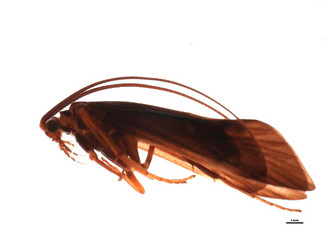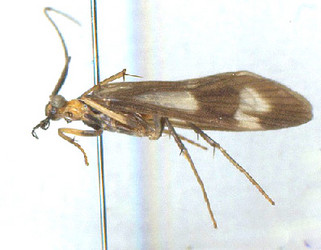Dipseudopsidae
Karl Kjer


This tree diagram shows the relationships between several groups of organisms.
The root of the current tree connects the organisms featured in this tree to their containing group and the rest of the Tree of Life. The basal branching point in the tree represents the ancestor of the other groups in the tree. This ancestor diversified over time into several descendent subgroups, which are represented as internal nodes and terminal taxa to the right.

You can click on the root to travel down the Tree of Life all the way to the root of all Life, and you can click on the names of descendent subgroups to travel up the Tree of Life all the way to individual species.
For more information on ToL tree formatting, please see Interpreting the Tree or Classification. To learn more about phylogenetic trees, please visit our Phylogenetic Biology pages.
close boxIntroduction
Dipseudopsidae is a relatively small family of about 170 species originally recognized by Ulmer (1904) as a subfamily of Polycentropodidae. Similarities in the larvae in the 2 major subfamilies provided convincing evidence that Hyalopsyche, at one time assigned to a separate family, Hyalopsychidae Lestage (e.g., Neboiss 1989), should be included with Dipseudopsis in the Dipseudopsidae (Wells & Cartwright 1993). Currently, 8 genera are recognized in 3 subfamilies: Dipseudopsinae with Dipseudopsis Walker, (ca. 80 species widespread in Africa and Asia), Limnoecetis Marlier (2 African species), and Protodipseudopis Ulmer (5 African species); Hyalopsychinae with Hyalopsyche Ulmer (10 Asian species), Hyalopsychella Ulmer (2 species from Borneo and Sulawesi), and Phylocentropus Banks (ca. 10 species from eastern North America, Southeast Asia, and Japan); and Pseudoneureclipsinae with Pseudoneureclipsis (more than 60 species from the western Palaearctic, Oriental, and Afrotropical regions) and Antillopsyche Banks (4species from the Greater Antilles). (From Holzenthal et al. 2007a)
Characteristics
Larvae constructand live in elaborate nets, formed into elongate silken tubes covered with sand. These tubes are buried in the sediment in Phylocentropus, functioning like a siphon with the larva occupying a lateral branch.Discussion of Phylogenetic Relationships
Pseudoneureclipsinae was only relatively recently transferred to Dipseudopsidae from Polycentropodidae (Li et al. 2001, Tachet et al. 2001), based on cladistic considerations. Only Pseudoneureclpsis Ulmer was officially transferred to Dipseudopsidae, but Antillopsyche would have to be transferred also by inference, since it was placed in the same subfamily by Flint (1964). Molecular data confirm that Pseudoneureclipsinae (including both Pseudoneureclpsis and Antillopsyche) may not belong with the Polycentropodidae, but its placement within Dipseudopsidae is not always recovered, and some analyses place them as the sister taxon to Polycentropodidae (Holzenthal et al., 2007b). The larvae of Pseudoneureclipsinae have a very different morphology and ecology from typical Dipseudopsidae (Flint 1964, Tachet et al. 2001) and their placement in this family should be considered provisional.References
Flint, O.S., Jr. (1964) The caddisflies (Trichoptera) of Puerto Rico. University of Puerto Rica, Agricultural Experiment Station, Technical Paper, 40, 1–80.
Holzenthal R.W., Blahnik, R.J., Prather, A.L., and Kjer K.M. 2007a. Order Trichoptera Kirby 1813 (Insecta), Caddisflies. In: Zhang, Z.-Q., and Shear, W.A. (Eds). 2007 Linneaus Tercentenary: Progress in Invertebrate Taxonomy. Zootaxa. 58 pp. 1668:639-698
Holzenthal R.W., Blahnik, R.J., Kjer K.M and Prather, A.L. 2007b. An update on the phylogeny of Caddisflies (Trichoptera). Proceedings of the XIIth International Symposium on Trichoptera. Bueno-Soria, R. Barba-Alvearz and B. Armitage (Eds). pp. 143-153. The Caddis Press.
Li, Y.J., Morse, J.C. & Tachet, H. (2001) Psedoneureclipsinae in Dipseudopsidae (Trichoptera: Hydropsychoidea), with descriptions of two new species of Pseudoneureclipsis from east Asia. Aquatic Insects, 23, 107–117.
Neboiss, A. (1989) Caddis-flies (Trichoptera) of the families Polycentropodidae and Hyalopsychidae from Dumoga-Bone National Park, Sulawesi, Indonesia, with comments on identity of Polycentropus orientalis McLachlan. Bulletin Zoölogisch Museum, Universiteit van Amsterdam, 12, 101–110.
Tachet, H., Morse, J.C. & Berly, A. (2001) The larva and pupa of Pseudoneureclipsis lusitanicus Malicky, 1980 (Trichoptera: Hydropsychoidea): description, ecological data and taxonomical considerations. Aquatic Insects, 23, 93–106.
Ulmer, G. (1904) Ueber Westafricanische Trichopteran. Zoologischer Anzeiger, 28, 353–359.
Wells, A. & Cartwright, D. (1993) Females and immatures of the Australian caddisfly Hyalopsyche disjuncta Neboiss (Trichoptera), and a new family placement. Transactions of the Royal Society of South Australia, 117, 97–104.
Title Illustrations

| Scientific Name | Dipseudopsis benardi |
|---|---|
| Location | Mae Hong Son Thailand |
| Creator | Karl Kjer |
| Specimen Condition | Dead Specimen |
| Identified By | Hans Malicky |
| Sex | Male |
| Life Cycle Stage | Adult |
| View | Lateral |
| Source Collection | Barcode of Life Database (BOLD) |
| Scientific Name | Dipseudopsis nebulosa |
|---|---|
| Location | Pahang Malaysia |
| Creator | Karl Kjer |
| Specimen Condition | Dead Specimen |
| Identified By | Ralph W. Holzenthal |
| Sex | Male |
| Life Cycle Stage | Adult |
| Collection | Univeristy of Minnesota UMSP |
| Collector | Clausen, P J |
| Source Collection | Barcode of Life Database (BOLD) |
About This Page
Karl Kjer

Rutgers University, New Brunswick, New Jersey, USA
Correspondence regarding this page should be directed to Karl Kjer at
Page copyright © 2010 Karl Kjer
 Page: Tree of Life
Dipseudopsidae.
Authored by
Karl Kjer.
The TEXT of this page is licensed under the
Creative Commons Attribution-NonCommercial License - Version 3.0. Note that images and other media
featured on this page are each governed by their own license, and they may or may not be available
for reuse. Click on an image or a media link to access the media data window, which provides the
relevant licensing information. For the general terms and conditions of ToL material reuse and
redistribution, please see the Tree of Life Copyright
Policies.
Page: Tree of Life
Dipseudopsidae.
Authored by
Karl Kjer.
The TEXT of this page is licensed under the
Creative Commons Attribution-NonCommercial License - Version 3.0. Note that images and other media
featured on this page are each governed by their own license, and they may or may not be available
for reuse. Click on an image or a media link to access the media data window, which provides the
relevant licensing information. For the general terms and conditions of ToL material reuse and
redistribution, please see the Tree of Life Copyright
Policies.
- First online 20 July 2010
- Content changed 20 July 2010
Citing this page:
Kjer, Karl. 2010. Dipseudopsidae. Version 20 July 2010 (under construction). http://tolweb.org/Dipseudopsidae/14566/2010.07.20 in The Tree of Life Web Project, http://tolweb.org/









 Go to quick links
Go to quick search
Go to navigation for this section of the ToL site
Go to detailed links for the ToL site
Go to quick links
Go to quick search
Go to navigation for this section of the ToL site
Go to detailed links for the ToL site